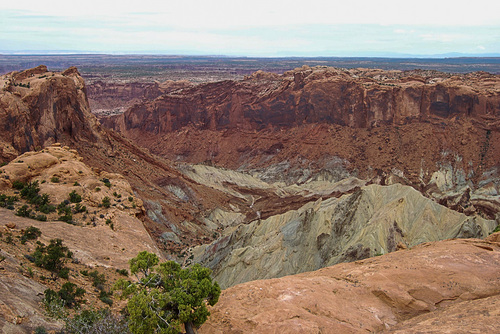This is an archived article that was published on sltrib.com in 2014, and information in the article may be outdated. It is provided only for personal research purposes and may not be reprinted.
Gov. Gary Herbert said he has been assured by the top levels of the Obama administration that the White House won't designate a new national monument in southeastern Utah as long as a more comprehensive public-lands effort is making headway.
Herbert met with Interior Secretary Sally Jewell during a trip to Washington last week and told her that Utah didn't want any "surprises" with the designation of the Greater Canyonlands National Monument, a proposed 1.8 million-acre area that environmental groups and some Democratic senators have urged President Barack Obama to protect using his power under the Antiquities Act.
"They've promised me that's not going to happen," Herbert said during his monthly KUED news conference, adding later that he heard similar comments directly from the president.
"I've heard [Obama] say it: 'As long as Congress is moving ahead [with the lands initiative] I won't do it. It's if Congress is not, it's something I can do myself,'" Herbert said.
The governor said he expects it will take about a year to determine if the Public Lands Initiative will yield an agreement that can be sent to Congress for approval.
Jewell told Herbert that the monument will be on hold as long as progress was being made on the more holistic initiative being spearheaded by Rep. Rob Bishop, aimed at resolving land disputes on some 18 million acres.
"I can only say what Secretary Jewell said to me and that is, 'We have no plans to do this. It's not what we want to do. We like the fact you're working on a comprehensive plan bringing all stakeholders together," Herbert said.
Bishop has been working with county leaders, outdoor enthusiasts and other interested parties to try to resolve public-land management issues, including the potential designation of new wilderness areas, that have been a point of friction in Utah for decades.
If Bishop's land initiative breaks down, Herbert said, Obama could reconsider designating the national monument, but the governor was assured there would be a public process leading up to that.
Environmental groups and the Navajo Nation have pressed Obama to use his executive power to create the national monument — much like then-President Bill Clinton did in designating the Grand Staircase-Escalante National Monument in 1996.
"They're not going to do the Bill Clinton, stealth approach and say to the governor, 'We're not going to do it,' and then a few days later announce they're going to do it," Herbert said.
David Garbett, an attorney with the Southern Utah Wilderness Alliance, said the secretary's commitment regarding the monument isn't surprising.
"I think it makes sense, because the Greater Canyonlands that we are targeting for monument designation is a place that needs to be protected," he said. Pursuing a the lands initiative makes sense, but the time is limited.
"So we have this brief window to try to add protection for this area," Garbett said. "But it is a brief window and if this Public Lands Initiative isn't working, then a monument shouldn't be a surprise."
Rep. Jason Chaffetz, R-Utah, has credited the Obama administration with letting negotiations continue, but he agrees that time is running out. He expects Bishop to introduce legislation early next year.
"We are not going to force something on the counties," he said. "But there is going to come a time after the turn of the new year when they are either in or out."
And he thinks there's plenty of incentive for them to stay in the process. Beyond the land set aside for drilling, Chaffetz anticipates the legislation would create more wilderness in a single act than has ever been done in the continental United States. That may be a big enough carrot for the president to agree to give away any future president's right to create national monuments in the participating counties.
"If they don't participate, there's not much I can do to protect them from the president just doing one unilaterally without any of their input," said Chaffetz, whose district contain the area that would be included in a proposed Greater Canyonlands National Monument.
Grand County Council Chairman Lynn Jackson, for one, said his county — which would be included in the proposed monument — hopes to have a proposal on Bishop's desk by the end of fall.
"We've heard that the president is willing to honor this process as long as we are moving forward and that's great. We are tickled to hear that," Jackson said.
But he acknowledges residents are divided on which areas should be protected and which should be open for development.
"If it were easy it would be done a long time ago," he said.
This summer, 14 liberal senators joined the call for the creation of a new monument. Herbert responded with a letter inviting the senators to come to Utah to tour the area and encouraged them to support Bishop's work.
Twitter: @RobertGehrke
Matt Canham and Brian Maffly contributed to this report.



